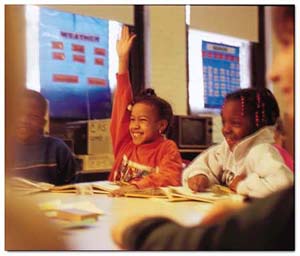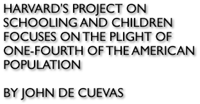
Main Menu ·
Search ·
Current Issue · Contact · Archives · Centennial · Letters to the Editor · FAQs

 |
 | First-grade pupils at the Longfellow School in Cambridge. Photograph by David Zadig
|
|

See sidebar profiles of Sara Lawrence-Lightfoot, Henry Rosovsky, Katherine Merseth, Charles Deutsch, and Martha Minow
There are 66 million children under the age of 18 in this country-one-fourth
of the population. One out of every four of our children lives in poverty,
which ranks the United States worst among 18 Western industrialized nations.
America's children are also more likely than children in other industrialized
nations to suffer from bad health, broken families, and a variety of other
social ills, and to be poorly educated. Two-thirds of our eighth- graders
say they have tried tobacco, alcohol, or marijuana, and one-fourth are current
drinkers. About one-fourth of girls and one-third of boys are sexually active
before their fifteenth birthdays. Teenage pregnancies and births to
unwed mothers are higher in the U.S. than in most other developed countries.
Our children watch hundreds of hours of television every year, much of it
depicting violence, and they are themselves subject to violence: one-fourth
of all 10- to 16-year-olds report having been victims of assault or abuse.
About 80 percent of all children attend public schools, but 42 percent of
fourth-graders score below proficiency level in reading and 41 percent
score below proficiency level in math. In 1994 only 2 percent of eighth-graders
read at or above an advanced level.
What can Harvard do about the plight of children? Two catalogs recently
published by the Harvard Project on Schooling and Children (HPSC) suggest
that the University has ample resources to bring to bear on their problems.
A Student Guide and Course Listing covers 246 courses on children
offered throughout Harvard, and a Faculty Research Guide describes
the research and teaching of 120 faculty members engaged in children's issues.
One of HPSC's goals is to marshal those resources and make effective use of
them.
The schooling and children project is one of five initiatives that
President Neil L. Rudenstine created at the outset of Harvard's current
capital campaign to address issues of national concern through interdisciplinary
discussion and research. In his 1991-1993 President's Report, Rudenstine
suggested that HPSC would "focus on timely questions of public policy
[and] grapple with specific problems faced inside the schools and in
surrounding communities" through "research projects, public colloquia
and forums, special seminars, advanced training programs, and joint work
withother educational programs."
Since its inception, HPSC's executive committee-cochaired by professor
of education Sara Lawrence-Lightfoot and Geyser University professor emeritus
Henry Rosovsky-has further defined HPSC's mission. The initiative should
"enhance children's learning and strengthen the capacities of adults
and institutions crucial to that goal" by examining "the relationships
among the several institutions that influence children's learning,
including schools, families, community agencies, and social and health networks."
As HPSC executive director Katherine K. Merseth, lecturer on education,
emphasizes, "We're about a new way for people at Harvard to think,
work, and collaborate-not just business as usual, but a new way of doing
business."
As part of its new way of doing business, HPSC has received approval for
a Core Curriculum course in the College on children's issues, to be offered
for the first time this spring. "Children and Their Social Worlds,"
as envisioned by its organizers, professors Martha Minow (law), Jerome Kagan
(psychology), and Robert Levine (education, anthropology), will use the
perspectives of history, psychology, anthropology, sociology, and law to
consider problems that contemporary children face from infancy to puberty.
The course will deal with issues of adoption, education, sexual and ethnic
identity, juvenile delinquency, abuse and neglect, and poverty. It will
incorporate field work in which students observe children, or deal
with children's issues, in educational, medical, legal, and social-service
settings.
In fact, HPSC intends to establish a new undergraduate concentration in
children's studies similar to those in women's and Afro-American studies.
Making use of research, community collaboration, and courses and training
programs, the concentration would address, among other themes, how children's
identities affect success in schools; what changes in social arrangements
can promote resilience for children facing adverse circumstances; and what
explains the place of children in this nation's public discourse and practice.
To serve its broader goals, HPSC has created four task forces that focus,
respectively, on "the ecology of schooling" (in Lawrence-Lightfoot's
words); innovative schools; the evaluation of intervention programs; and
a reassessment of America's commitment to children. Each of the task forces
has enlisted participants from across the University in its seminars and
discussions.
Each in its way has had to deal with frustration, "even paralysis,"
as Minow puts it, because children's health and welfare, and their education
as future citizens, constitute such a complex set of issues. Minow points
out that Americans have historically been unwilling to deal with children
through national policy and legislation the way other industrialized countries
do. "We have a longstanding national skepticism about the state,"
she suggests, "a resistance to state intervention in our private lives
that goes back to the Revolution. We view children as private concerns,
and we have come up with a political ideology and a legal system that protect
privacy. The formation of families and the care and raising of children
are private responsibilities in which the state must not intrude. That's
a very powerful view."
It is a view that HPSC hopes to change through Harvard's leadership. Lawrence-Lightfoot,
for example, has enjoined a group of experts from various fields to
consider the ecology of schooling, a notion that embraces not only what
happens inside schools-how teachers teach and how children learn-but also
the place of schools in the community, especially in cities. "We are
concerned," she says, "with children's socialization and development--at
home, in schools, in the streets--how kids and their parents negotiate the
intersection of all those things in their lives." The group's mission
is to elucidate who the actors are, what institutions are involved, and
what can be done to make them more effective in helping children learn-in
particular, what HPSC can do to enable people and institutions outside the
schools to help children learn. Lawrence-Lightfoot and the group are seeking
to develop a language that's understandable not only to researchers but
also to policymakers and school people, "so they don't end up asking
what in the world we're talking about." Beyond that, the group will
develop research, policy, and programs that not only apply locally but can
also be "scaled up" to a national level.
But scaling up to a national level is not easy. The growth of centralized
bureaucracy in schools poses a problem, says professor of psychology Sheldon
White, a member of the ecology task force. Recalling Herman Wouk's description
of the U.S. Navy as "a system designed by geniuses requiring execution
by idiots," White has written, "If you talk to local school people,
you get the impression that just the opposite situation exists. Schools
and social-service structures are systems designed by idiots requiring execution
by geniuses.If they are to be responsive to local family and community circumstances,
they need some latitude with which to deviate from nationally imposed conceptions
and standards."
The irony is that there are no nationally imposed standards for schools:
every state runs its own school system, and even within states many school
boards operate quasi-independently. As HPSC executive director Merseth notes,
the U.S. has some 16,000 separate school districts. Within those districts
school management is largely top-down rather than bottom-up: centralized
bureaucracies have authority to oversee both curriculum and budgets. There
are exceptions, of course. A few schools with innovative programs have been
notably successful; among the best known is the Central Park East school
in Harlem, founded by Deborah Meier, LL.D. '93, where students' reading
and math skills are well above average, and drop-out rates well below. As
Merseth observes of the Harlem school, vision and leadership can be powerful
aids to overcoming bureaucratic constraints.
Promoting a National Love of Children, continued...
Main Menu ·
Search · Current Issue · Contact · Archives · Centennial · Letters to the Editor · FAQs

![]()



![]()